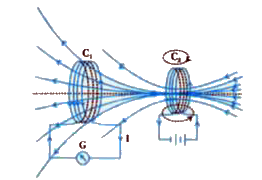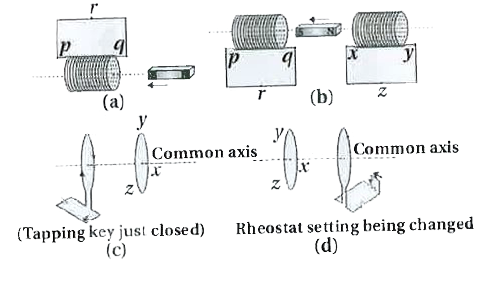
Consider Experiment:
(a) What would you do to obtain a large deflection of the galvanometer ?
(b) How would you demonstrate the presence of an induced current in the absence of a galvanometer ?Solution in Gujrati
(a) To obtain a large deflection, one or more of the following steps can be taken: (i) Use a rod made of soft iron inside the coil C2 , (ii) Connect the coil to a powerful battery, and (iii) Move the arrangement rapidly towards the test coil C1 .
(b) Replace the galvanometer by a small bulb, the kind one finds in a small torch light. The relative motion between the two coils will cause the bulb to glow and thus demonstrate the presence of an induced current.
In experimental physics one must learn to innovate. Michael Faraday who is ranked as one of the best experimentalists ever, was legendary for his innovative skills.
Topper's Solved these Questions
- BOOK - NCERT GUJARATICHAPTER - ELECTROMAGNETIC INDUCTIONEXERCISE - EXERCISES10videos
ELECTROMAGNETIC INDUCTION
- BOOK - NCERT GUJARATICHAPTER - ELECTROMAGNETIC INDUCTIONEXERCISE - ADDITIONAL EXERCISES7videos
ELECTROMAGNETIC INDUCTION
- BOOK - NCERT GUJARATICHAPTER - ELECTRIC CHARGES AND FIELDS EXERCISE - EXERCISES34videos
ELECTRIC CHARGES AND FIELDS
- BOOK - NCERT GUJARATICHAPTER - ELECTROMAGNETIC WAVESEXERCISE - ADDITIONAL EXERCISES5videos
ELECTROMAGNETIC WAVES
Similar Questions
Predict the direction of induced current in the situations described by the following figures (a) to (d).
 03:06View Solution
03:06View SolutionSuppose the loop is stationary but the current feeding the electromagnet that produces the magnetic field is gradually reduced so that the field decreases from its initial value of 0.3 T at the rate of 0.02 T s−1. If the cut is joined and the loop has a resistance of 1.6 Ω, how much power is dissipated by the loop as heat ? What is the source of this power ?
04:59View SolutionWhat is the force between two small charged speres having charges of 2×10−7 c and 3×10−7 c placed 30 cm apart in air
01:16View SolutionSuppose that the electric field part of an electromagnetic wave in vacuum is →E={(3.1N/C)cos[(1.8rad/m)y+(5.4×106rad/s)]}ˆi
What is the direction of propagation ?02:57View SolutionConsider Experiment 2, Art. 4(a). 3, (a) What would you do to obtain a large deflection of the galvanometer ? (b) How would you demonstrate the presence of an induced current in the absence of a galvanmeter ?
02:45View SolutionConsider experiment 6.2 (a) What would you do to get more deflection in the dielectric? (b) How would you indicate the presence of an induced current in the absence of a thermometer?
03:23View SolutionWhat would you do to obtain a large deflection of the galvanometer?
02:53View SolutionHow would you demonstrate the presence of an induced current in the absence of a gal-vanometer ?
View Solutionफैराडे एवं हेनरी के प्रयोग संख्या दो में विचार करके बताइए -
धारामापी की अनुपस्थिति में आप प्रेरित धारा की उपस्थिति किस प्रकार दर्शाएँगे ?View SolutionConsider Experiment II in Section 6.2.
a. What would you do to obtain a large deflection of the galvanometer?
b. How would you demonstrate the presence of an induced current in the absence of a galvanometer?03:23View SolutionConsider Experiment 6.2. (a) What would you do to obtain a large deflection of the galvanometer? (b) How would you demonstrate the presence of an induced current in the absence of a galvanometer?
04:56View SolutionConsider Experiment 6.2. (a) What would you do to obtain a large deflection of the galvanometer? (b) How would you demonstrate the presence of an induced current in the absence of a galvanometer?
04:44View SolutionConsider Experiment 6.2. (a) What would you do to obtain a large deflection of the galvanometer? (b) How would you demonstrate the presence of an induced current in the absence of a galvanometer?
01:42View SolutionConsider Experiment II in Section 6.2.
a. What would you do to obtain a large deflection of the galvanometer?
b. How would you demonstrate the presence of an induced current in the absence of a galvanometer?01:13View SolutionConsider Experiment 2, Art. 4(a). 3,
(a) What would you do to obtain a large deflection of the galvanometer ?
(b) How would you demonstrate the presence of an induced current in the absence of a galvanmeter ?04:19View Solution

